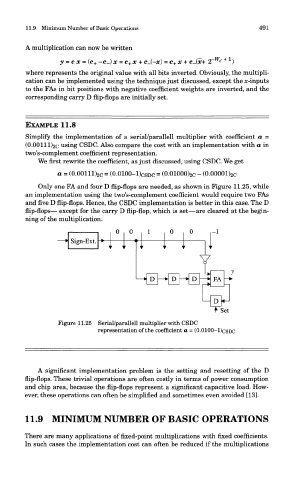Page 506 - DSP Integrated Circuits
P. 506
11.9 Minimum Number of Basic Operations 491
A multiplication can now be written
where represents the original value with all bits inverted. Obviously, the multipli-
cation can be implemented using the technique just discussed, except the ^-inputs
to the FAs in bit positions with negative coefficient weights are inverted, and the
corresponding carry D flip-flops are initially set.
EXAMPLE 11.8
Simplify the implementation of a serial/parallell multiplier with coefficient a =
(0.00111)2c using CSDC. Also compare the cost with an implementation with a in
two's-complement coefficient representation.
We first rewrite the coefficient, as just discussed, using CSDC. We get
Only one FA and four D flip-flops are needed, as shown in Figure 11.25, while
an implementation using the two's-complement coefficient would require two FAs
and five D flip-flops. Hence, the CSDC implementation is better in this case. The D
flip-flops— except for the carry D flip-flop, which is set—are cleared at the begin-
ning of the multiplication.
Figure 11.25 Serial/parallell multiplier with CSDC
representation of the coefficient a = (0.0100—l)csDC
A significant implementation problem is the setting and resetting of the D
flip-flops. These trivial operations are often costly in terms of power consumption
and chip area, because the flip-flops represent a significant capacitive load. How-
ever, these operations can often be simplified and sometimes even avoided [13].
11.9 MINIMUM NUMBER OF BASIC OPERATIONS
There are many applications of fixed-point multiplications with fixed coefficients.
In such cases the implementation cost can often be reduced if the multiplications

